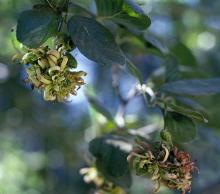See:
Peach (Prunus persica) - Leaf Curl
Cause The fungi Taphrina japonica is associated with leaf curl while T. occidentalis is associated with catkin hypertrophy. Spores overwinter on bud scales and twigs. Infection occurs as leaves emerge in the spring. This is seldom a significant problem in the PNW.
Symptoms Catkin scales enlarge and twist so that they look like reddish, curled tongues. A white, glistening layer of spores may develop on the surface of infected catkins. Leaves of red alder enlarge to several times normal size. They are generally curled, distorted, and turn purple. These leaves will shrivel, dry and fall off the tree. Trees will then have a new flush of leaf growth.
Chemical control Applied in the dormant season before buds begin to grow in the spring.
- Lime Sulfur Ultra (27% Lime Sulfur) at 1.5 to 2 gal/100 gal water plus light medium summer oil. Do not allow to drift onto evergreens as conifers will be defoliated. Not for residential use or application to residential sites. 48-hr reentry. O
- Rex Lime Sulfur (28% Lime Sulfur) at 3 to 4 gal/100 gal water plus light medium summer oil. Do not allow to drift onto evergreens as conifers will be defoliated. Not for residential use or application to residential sites. 48-hr reentry. O
Reference Dugan, F.M., and Newcombe, G. 2007. New records for powdery mildews and Taphrina species in Idaho and Washington. Pacific Northwest Fungi 2:1-5.



